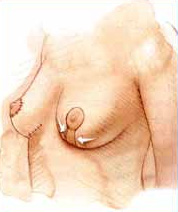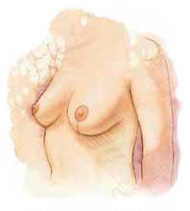|
|
Loss of skin elasticity, gravity and other factors such as weight loss, pregnancy and breast-feeding ultimately affect the shape and firmness of your breasts. Patients who are generally satisfied with the size of their breasts can have a breast lift to raise and firm them, resulting in a more youthful breast contour. Some patients may be unhappy that they have lost a significant amount of breast volume over time. In such cases, implants inserted in conjunction with a breast lift can increase breast size at the same time as the shape and position of the breasts are enhanced.
During the consultation, you will be asked about your desired breast shape and size. Your plastic surgeon will discuss with you how your nipples and areolas will be repositioned. You should mention anything else about your breasts that you would like to see improved. This will help your surgeon to understand your expectations and determine whether they realistically can be achieved.
Your plastic surgeon will examine your breasts, taking measurements and perhaps photographs for your medical record. The size and shape of your breasts, the quality of your skin, and the placement of the nipples and areolas will be carefully evaluated.
You should come to the consultation prepared to discuss your medical history. This will include information about any medical conditions, drug allergies, medical treatments you have received, previous surgeries including breast biopsies, and medications that you currently take. It is important for you to provide complete information.
You should tell your plastic surgeon if you plan to lose a significant amount of weight, particularly if you have noticed that your breasts sag or become smaller with weight loss. Your surgeon may recommend that you stabilize your weight before having surgery.
How a Breast Lift Is Performed
Individual factors and personal preferences will determine the specific technique selected to lift your breasts.
Incisions following the breast's natural contour define the area of excision and the new location for the nipple and areola. Skin in the shaded area is removed, and the nipple and areola are moved to a higher position.
Where are the incisions placed?
 A common method of lifting the breasts involves three incisions. One incision is made around the areola. Another runs vertically from the bottom edge of the areola to the crease underneath the breast. The third incision is horizontal beneath the breast and follows the natural curve of the breast crease. A common method of lifting the breasts involves three incisions. One incision is made around the areola. Another runs vertically from the bottom edge of the areola to the crease underneath the breast. The third incision is horizontal beneath the breast and follows the natural curve of the breast crease.
After the plastic surgeon has removed excess breast skin, the nipple and areola are shifted to a higher position. The areola, which in a sagging breast may have been stretched, can be reduced in size. Skin that was formerly located above the areola is brought down and together beneath it to reshape the breast.
The nipples and areolas remain attached to underlying mounds of tissue, and this usually allows for the preservation of sensation and the ability to breast-feed.
Skin formerly located above the areola is brought down and together beneath it to reshape the breast.
What are some variations to the common breast lifting technique?
 There are many variations to the design of the incisions for breast lift surgery. The size and shape of your breasts, size of your areolas, and extent of sagging are factors that will help your plastic surgeon determine the best technique for you. There are many variations to the design of the incisions for breast lift surgery. The size and shape of your breasts, size of your areolas, and extent of sagging are factors that will help your plastic surgeon determine the best technique for you.
In some instances, it may be possible to avoid the horizontal incision beneath the breast. Sometimes a technique may be used that avoids this horizontal incision as well as the vertical incision that runs from the bottom edge of the areola to the breast crease.
If you are a good candidate for a modified technique, your plastic surgeon will discuss this with you.
If you and your plastic surgeon have decided that it is desirable to enlarge your breasts at the same time as they are lifted, this will require insertion of breast implants. If this is an option that you wish to consider, your surgeon will review the necessary information with you and may provide you with a brochure on breast augmentation.
Understanding Risks
Fortunately, significant complications from breast lifts are infrequent. Every year, many thousands of women undergo successful breast lift surgery, experience no major problems and are pleased with the results. Anyone considering surgery, however, should be aware of both the benefits and risks.
I understand that every surgical procedure has risks, but how will I learn more so that I can make an informed decision?
The subject of risks and potential complications of surgery is best discussed on a personal basis between you and your plastic surgeon, or with a staff member in your surgeon's office.
Some of the potential complications that may be discussed with you include bleeding, infection and reactions to anesthesia. Following a breast lift, sometimes the breasts may not be perfectly symmetrical or the nipple height may vary slightly. Minor adjustments often can be made at a later time. Permanent loss of sensation in the nipples or areas of breast skin may occur rarely. Revisionary surgery may sometimes be helpful in certain instances where incisions may have healed poorly.
You can help to lessen certain risks by following the advice and instructions of your plastic surgeon, both before and after surgery.
How should I prepare for surgery?
The goal of your plastic surgeon and the entire staff is to make your surgical experience as easy and comfortable for you as possible.
Depending on your age, or if you have a history of breast cancer in your family, your plastic surgeon may recommend a baseline mammogram before surgery and another mammographic examination some months after surgery. This will help to detect any future changes in your breast tissue. Following a breast lift, you will still be able to perform breast self-examination. Breast lift surgery will not increase your risk of developing breast cancer.
If you are a smoker, you will be asked to stop smoking well in advance of surgery. Aspirin and certain anti-inflammatory drugs can cause increased bleeding, so you should avoid taking these medications for a period of time before surgery. Your surgeon will provide you with additional preoperative instructions.
Breast lift surgery is usually performed on an outpatient basis. If this is the case, be sure to arrange for someone to drive you home after surgery and to stay with you at least the first night.
What will the day of surgery be like?
Your breast lift surgery may be performed in a hospital, free-standing ambulatory facility or office-based surgical suite.
Medications are administered for your comfort during the surgical procedure. Often, a general anesthetic is administered, so that you will be asleep throughout the procedure.
Alternatively, a breast lift may be performed using local anesthesia and intravenous sedation. When surgery is completed, you will be taken into a recovery area where you will continue to be closely monitored. Sometimes, small drain tubes will have been placed in your breasts to help avoid the accumulation of fluids. Gauze or other dressings may be placed on your breasts and covered with an elastic bandage or surgical bra.
You may be permitted to go home after a few hours, unless you and your plastic surgeon have determined that you will stay in the hospital or surgical facility overnight.
How will I look and feel initially?
The day after surgery, you will be encouraged to get out of bed for short periods of time. After several days, you should be able to move about more comfortably. Straining, bending and lifting must be avoided, however, since these activities might cause increased swelling or even bleeding. You may be instructed to sleep on your back to avoid pressure on your breasts.
Any surgical drains will be removed within a few days of surgery, at which time your dressings may also be changed or removed. You may be instructed to wear a support bra for a few weeks, until the swelling and discoloration of your breasts diminish. Generally, stitches will be removed in stages over a period of approximately three weeks, beginning about one week after surgery.
You may notice that you feel less sensation in the nipple and areola areas. This is usually temporary. It may, however, take weeks, months or even more than a year before sensation returns to normal. Your breasts may also require some time to assume a more natural shape. Incisions will initially be red or pink in color. They will remain this way for many months following surgery.
When can I resume my normal activities?
After breast lift surgery, it is often possible to return to work within a week or so, depending on your job. In many instances, you can resume most of your normal activities, including some form of mild exercise, after several weeks. You may continue to experience some mild, periodic discomfort during this time, but such feelings are normal. Severe pain should be reported to your doctor.
Any sexual activity should be avoided for a minimum of one or two weeks, and your plastic surgeon may advise you to wait longer. After that, care must be taken to be extremely gentle with your breasts for at least the next several weeks.
Results of a Breast Lift
Breast lift surgery will make your breasts firmer and more uplifted. The position of your areolas and nipples will be enhanced, and the size of your areolas will be aesthetically pleasing.
The incisions from your breast lift surgery will heal and fade over time. It is important to realize, however, that the incision lines will be permanently visible. In some instances, they will eventually be only faint lines. Certain individuals may have incision lines that are more noticeable. Fortunately, the incisions for your breast lift are in locations easily concealed by clothing, even low-cut necklines.
How long will the results last?
Unless you gain or lose a significant amount of weight or become pregnant, your new breast shape should remain fairly constant. However, gravity and the effects of aging will eventually alter the size and shape of virtually every woman's breasts. If, after a period of years, you again become dissatisfied with the appearance of your breasts, you may choose to undergo a second breast lift procedure to restore their more youthful contour and appearance.
Maintaining a Relationship with Your Plastic Surgeon
You will return to your plastic surgeon's office for follow-up care at prescribed intervals, at which time your progress will be evaluated. Once the immediate postoperative follow-up is complete, many surgeons encourage their patients to come back for periodic checkups to observe and discuss the long-term results of surgery.
Please remember that the relationship with your plastic surgeon does not end when you leave the operating room. If you have questions or concerns during your recovery, or need additional information at a later time, you should contact your surgeon.
|